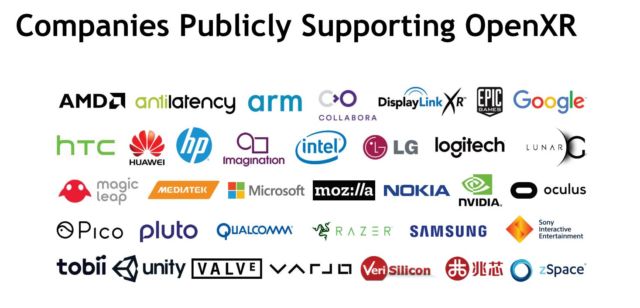Khronos Group Launches OpenXR 1.0 Adopter’s Program
The Khronos Group has been pushing full steam ahead with the implementation of its OpenXR standard over the past year following the establishment of the OpenXR v1.0 specifications in the summer of 2019. This week, Khronos announced the launch of the OpenXR Adopter’s Program, the implementation of which is already officially supported by Oculus and Microsoft. The two are also supporting cross vendor hand and eye tracking extensions.
Following the Microsoft and Oculus’ OpenXR support, it is now possible for developers to submit their OpenXR apps to the Oculus Store. The new Minecraft rendering engine RenderDragon is also leveraging the OpenXR platform as a basis for its desktop virtual reality support. In the meantime, Microsoft has already released an OpenXR-compliant runtime for its HoloLens 2 headset.

OpenXR is a royalty-free open standard that was built to make it possible for AR and VR developers to build platform-agnostic content that can run across a multiplicity of devices. It is already supported by some of the leading tech (including) VR heavyweights.
Developers wishing to begin new OpenXR-conformant apps and content can take their creations through OpenXR open-source conformance tests to aid them in their development efforts. Some of these tests are already available on Github under the Apache 2.0 license. The test suite allows any developer to send their open-source conformance test results so as to ensure that their products conform to the open standard regardless of whether they are Khronos Group members and based on this, they can subsequently become an OpenXR Early Adopter.
Apart from Oculus and Microsoft, other early implementers of the OpenXR open standard include various open-source products like Google’s Chromium81, the 3D creation suite Blender 2.83 and Varjo. Valve has previously unveiled an OpenXR developer preview implementation for SteamVR.
Cross-vendor hand and eye tracking extensions will considerably improve support for the two technologies. Another early adopter is Ultraleap which has launched a preview OpenXR integration for its hand-tracking technology.
According to the OpenXR Working Group chair Brent Insko, the Khronos Group has been putting “tremendous effort” to ensure OpenXR conformance testing which will lead to a “truly reliable cross-platform API”. The working group is currently encouraging OpenXR implementers to use these tests towards their own development and to consider making contributions towards additional tests which will further help in reducing cross-vendor variability. Insko continued that the release of the conformance tests along with the working group’s launch of the Adopters Program has widened the availability of OpenXR across multiple devices and expanded its use in large open-source projects, readying the OpenXR platform for “the next wave of adoption and deployment”.
There have also been some wins on the content front with Minecraft’s adoption of OpenXR in its desktop VR product further reinforcing Microsoft’s commitment to ensure OpenXR success. This could open the path for the rollout of Minecraft VR in various other devices.
https://virtualrealitytimes.com/2020/07/29/khronos-group-launches-openxr-1-0-adopters-program/https://virtualrealitytimes.com/wp-content/uploads/2019/03/OpenXR-Cross-Platform-Play-600x337.jpghttps://virtualrealitytimes.com/wp-content/uploads/2019/03/OpenXR-Cross-Platform-Play-150x90.jpgTechnologyThe Khronos Group has been pushing full steam ahead with the implementation of its OpenXR standard over the past year following the establishment of the OpenXR v1.0 specifications in the summer of 2019. This week, Khronos announced the launch of the OpenXR Adopter’s Program, the implementation of which is...Sam OchanjiSam Ochanji[email protected]EditorVirtual Reality Times - Metaverse & VR
